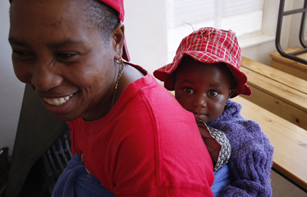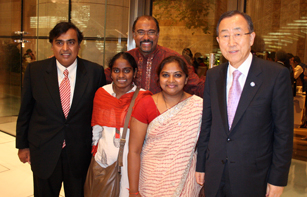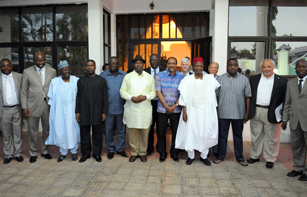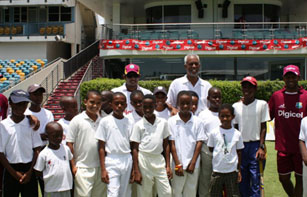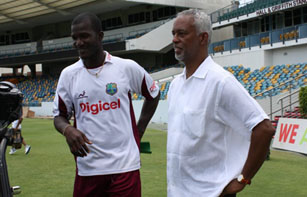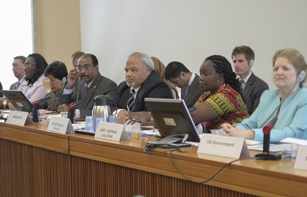
UNAIDS and PEPFAR bring together Health Ministers and partners from countries with the highest numbers of new HIV infections in children to scale up progress.
Credit: UNAIDS/A.Obeid
Ministers of Health and representatives from the 22* countries with the most new HIV infections in children have come together to report on progress towards achieving zero new HIV infections in children by 2015 and find ways of stepping up action.
In 2010, an estimated 390 000 children were born with HIV. However, with access to comprehensive HIV services the risk of transmission can be reduced to below 5%. In response to this, the Joint United Nations Programme on HIV/AIDS (UNAIDS) and the U.S. President's Emergency Plan for AIDS Relief (PEPFAR) convened partners to develop a global plan to stop new HIV infections among children by 2015 and keep their mothers alive. The plan focuses on the 22 countries in which 90% of new HIV infections in children occur, 21 of which are in sub-Saharan Africa.
“By uniting our forces across boundaries, institutions and communities, we will leverage this historic opportunity to welcome the first generation born free of HIV by 2015,” said UNAIDS Executive Director, Michel Sidibé. “By building bridges between the movements of AIDS, maternal and child health and women’s movements, we will quicken the pace of this race towards zero.”
Since the launch of the Global Plan at the 2011 High Level Meeting on AIDS, great strides have been made in reducing HIV infections among women of reproductive age and expanding access to antiretroviral therapy for pregnant women living with HIV. However, progress is not being scaled up as quickly on meeting the family planning needs of women living with HIV, preventing maternal mortality and ensuring that all children living with HIV have access to antiretroviral therapy. All of which are key elements in the global plan to achieve zero new HIV infections in children.
“We have the knowledge and the tools to ensure that all children are born HIV-free and that their mothers are healthy,” said United States Global AIDS Coordinator Ambassador Eric Goosby. “Countries are at the forefront of efforts to achieve this vision, and as partners, we are firmly committed to their success.”
By uniting our forces across boundaries, institutions and communities, we will leverage this historic opportunity to welcome the first generation born free of HIV by 2015
UNAIDS Executive Director Michel Sidibé
During her welcoming remarks, the Director General of the World Health Organization, Margaret Chan emphasized the full commitment of her organization towards the success of the Global Plan. “This is an ambitious, noble and achievable cause,” said Dr Chan. “It is also a great opportunity to make progress towards the integration of health services in countries.”
The President of the 65th World Health Assembly emphasized the need to raise awareness among communities to ensure that both men and women have access to HIV services for their own health and to prevent HIV infections in children. “Women still face stigma and discrimination when found HIV positive,” said the Health Minister from Côte d’Ivoire, Thérèse N’Dri-Yoman. “Women will not disclose their status and therefore won’t access HIV services unless communities provide them with the support they need.”
Ministers shared their ideas and experiences on four focus areas related to the implementation of the Global Plan: Financing and political ownership; quality of care; community engagement; and human resources.
Speaking about innovative methods of funding, Zimbabwe’s ‘AIDS Levy’ was praised as an example of a sustainable national initiative to mobilize resources for the AIDS response. “Even though no one likes to pay taxes, people are recognizing the utility of the AIDS Levy given the results achieved in the AIDS response,” said Zimbabwean Minister of Health and Child Welfare, Henry Madzorera.
Namibia’s Minister of Health and Social Services, Richard Kamwi, also explained how his country is rapidly increasing its domestic contribution to the overall resources allocated to the AIDS response.
The integration of services to provide better quality of care for women was also stressed as a key element by several countries. In Tanzania, for example, the Minister of Health and Social Welfare, Hussein Mwinyi, reported that currently all family planning services integrate HIV services and vice versa. Similarly, the Government of Ghana has issued a policy to provide free family planning to all. Botswana, one of the most advanced countries in preventing mother-to-child transmission of HIV, has integrated HIV services in all health settings providing antenatal care to pregnant women. “We are doing everything possible to bring health to people,” said Botswana’s Minister of Health John Seakgosing.
Countries like Burundi, Chad and the Democratic Republic of Congo reported efforts to increase the capacity of health care providers with initiatives such as nurse-driven antiretroviral treatment programmes, expanding service delivery outlets and promoting decentralization.
We have the knowledge and the tools to ensure that all children are born HIV-free and that their mothers are healthy
United States Global AIDS Coordinator Ambassador Eric Goosby
The importance of community engagement in implementing the Global Plan in countries was stressed by Lucy Ghati from the National Empowerment Network of People Living with HIV/AIDS in Kenya (NEPHAK). “Communities are critical if prevention of mother-to-child services are to be scaled up,” said Ms Ghati. “Women living with HIV must be represented on local and national committees to determine what their needs are as well as to ensure ownership of the response.” Similarly, France’s AIDS Ambassador Mireille Guigaz said, “Every time we look at the problems of women and children we have to get as close as possible to communities. If we don’t give them the opportunity to express how they feel and take their experiences into account, we won’t be able to provide a successful response to AIDS.”
The Deputy General Manager of the Global Fund to Fight AIDS, Tuberculosis and Malaria, Debrework Zewdie, noted that 15% of the funding for HIV prevention goes to the elimination of new HIV infections among children. However, she highlighted that the Global Fund is demand-driven and that countries must request the funds.
Sweden’s AIDS Ambassador Anders Nordström emphasized his country’s commitment to preventing new HIV infections among children and said that Sweden would be allocating US$ 15 million to support Global Plan efforts.
Business Leadership Council for a Generation Born HIV-Free CEO John Megrue reinforced the commitment of the private sector to eliminate new HIV infections among children and keep their mothers alive. He highlighted that the organization will focus its efforts on mobilizing resources among the private sector, advocating for other companies to join the council and to helping countries to accelerate implementation of the Global Plan.
The meeting was the first annual face-to-face gathering of representatives from the 22 focus countries since the launch of the Global Plan towards the Elimination of New HIV Infections among Children by 2015 and Keeping Their Mothers Alive in 2011.
*The 22 priority countries are: Angola, Botswana, Burundi, Cameroon, Chad, Côte d’Ivoire, Democratic Republic of the Congo, Ethiopia, Ghana, India, Kenya, Lesotho, Malawi, Mozambique, Namibia, Nigeria, South Africa, Swaziland, Uganda, United Republic of Tanzania, Zambia and Zimbabwe.









